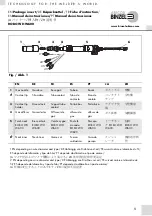
JABLOTRON
ALARMS
a.s.
Pod
Skalkou
4567/33
46601
Jablonec
n.
Nisou
Czech
Republic
www
.jablotron.com
||
|
JA-14K(R) Security System Control Panel
37 / 72
MNX22101
9.10 Obstacles preventing setting the system
According to
Ways of setting (
see Parameters tab)
,
the control panel may check for triggered or fault statuses
of individual devices or a particular section while setting each section of the system. In line with this option, the
control panel indicates some obstacles during setting (passable obstacles) and some of the statuses and may
even prevent the system from setting when they occur (impassable obstacles).
One of the most common obstacles is any system fault (indicated by a yellow system indicator), a loss of
connection with a wireless detector or a triggered status detector (typically a magnetic opening sensor) set with
a delayed zone reaction (front door and garage door sensors), low system battery, a long lasting power supply
failure or a communication fault of one of the communicators. It is influenced by the system profile.
An impassable obstacle preventing setting the system is for example a triggered
status detector
(usually
a magnetic door opening sensor) set up to an
Instant
reaction. Devices which belong in this group are window
opening, balcony or backdoor detectors but it can also be critical systems faults such as fault of backup power
supply or fault of communication to the ARC. The reasons which prevent system settings are different according
to the pre-set system profile. An exception in preventing the system from setting a section which doesn’t check
for any triggered detectors or faults is the automatic setting by a calendar using the option “Set … Always”.
The calendar will always set each section provided it’s configured to perform such an action.
Pulse detector triggering (e.g. motion detectors) cannot prevent setting.
System informs you about setting with an active zone by SMS report (to group of users with predefined alarm
reports) with a detailed description.
Ways of setting - table overview
System keypad
Via voice
menu/SMS/remote
controller/calendar
N-Link
Web and smart app
Set always
Will set always despite faults
or triggered devices status
Will set always
despite faults or
triggered devices
status
Will set always
despite faults or
triggered devices
status
Will set always despite
faults or triggered devices
status
Set with
warning
While attempting to set with a
fault or a triggered device, the
keypad flashes for 8 s after
which the system will
automatically set. It’s possible
to set the system by pressing
the functional button again or
by pressing the Enter key.
Will set always
despite faults or
triggered devices
status
Will set always
despite faults or
triggered devices
status
Will set according to
“Ways of setting” in the
Service configuration tab
Set after
confirmation
While attempting to set with a
fault or a triggered device, the
keypad flashes for 8 s after
which the system will
automatically set. It’s possible
to set the system by pressing
the functional button again or
by pressing the Enter key.
Will set always
despite faults or
triggered devices
status
Will set always
despite faults or
triggered devices
status
Will set according to
“Ways of setting” (with Set
with check / set with no
check) in the Service
configuration tab
Will not set
with an
active
element
While attempting to set with a
fault or a triggered device, the
keypad flashes for 8 s after
which the system will
automatically set. It’s possible
to set the system by pressing
the functional button again or
by pressing the Enter key.
Will not set when a
triggered detector is
set to an INSTANT
zone reaction
Will always set
despite faults or a
triggered devices
status
Will not set when a
triggered detector is set to
an INSTANT zone
reaction
9.11 Unsuccessful setting
It is a security function thanks to which the control panel checks within the exit delay if setting the system
can be executed and the security of the protected premises is not limited by the following cases. If the function
is enabled, then
unsuccessful setting
can be caused by:
1. Instant detector activation anytime during the exit delay (someone enters to an already protected area)
2. Permanent activation of a detector with a delay reaction after the exit time has already expired (The user
forgot to close the main door, garage or gate, etc..)
















































